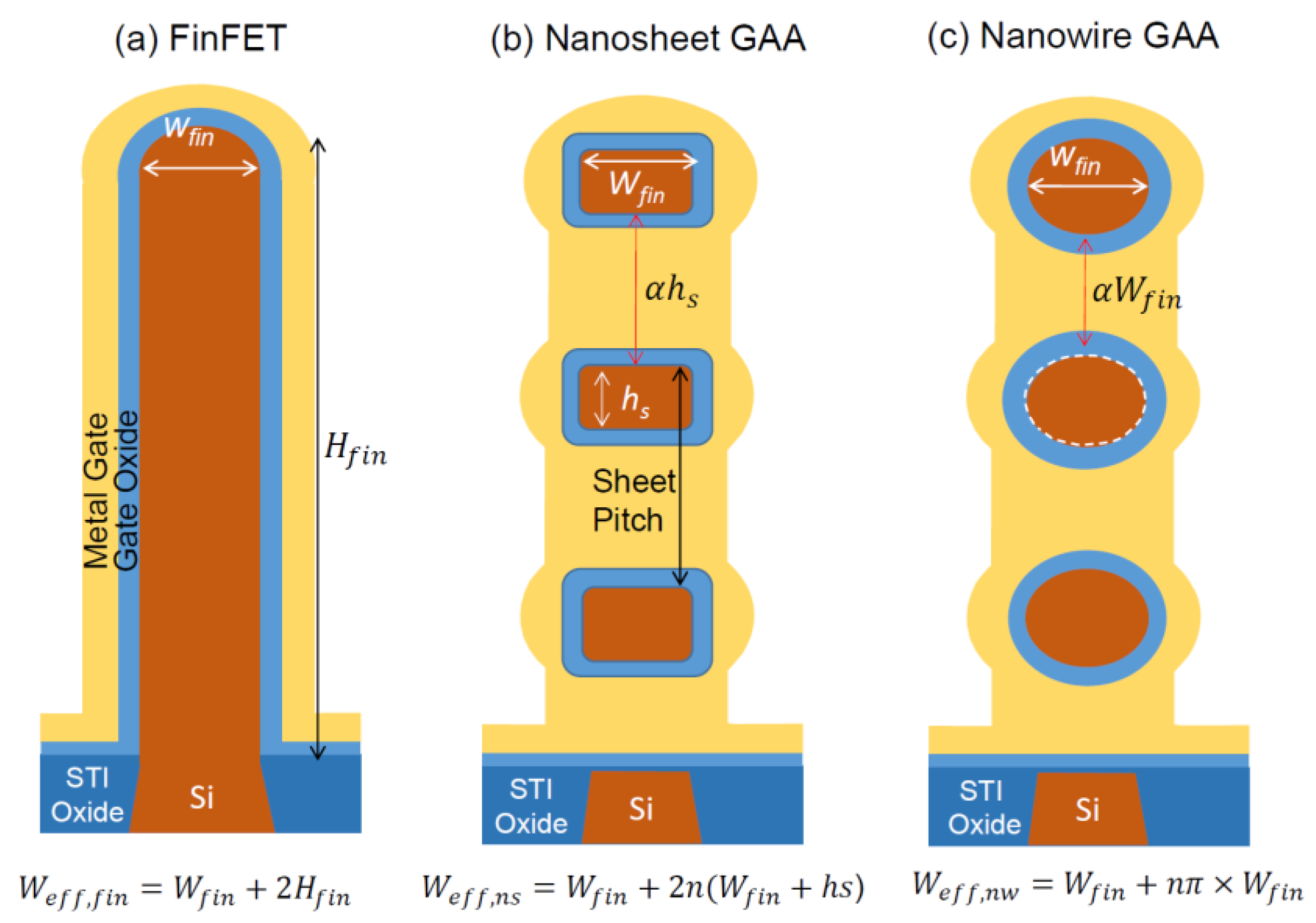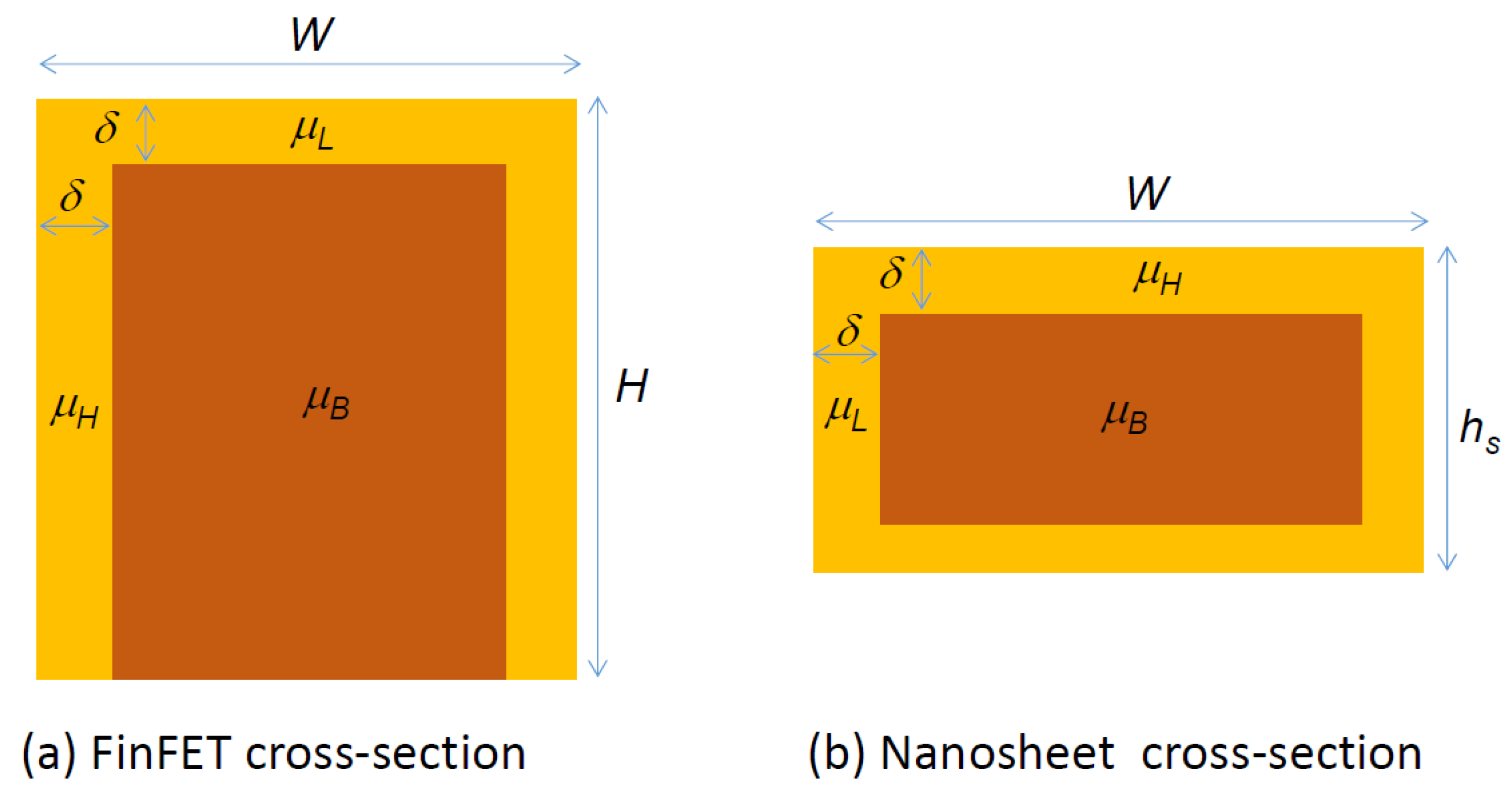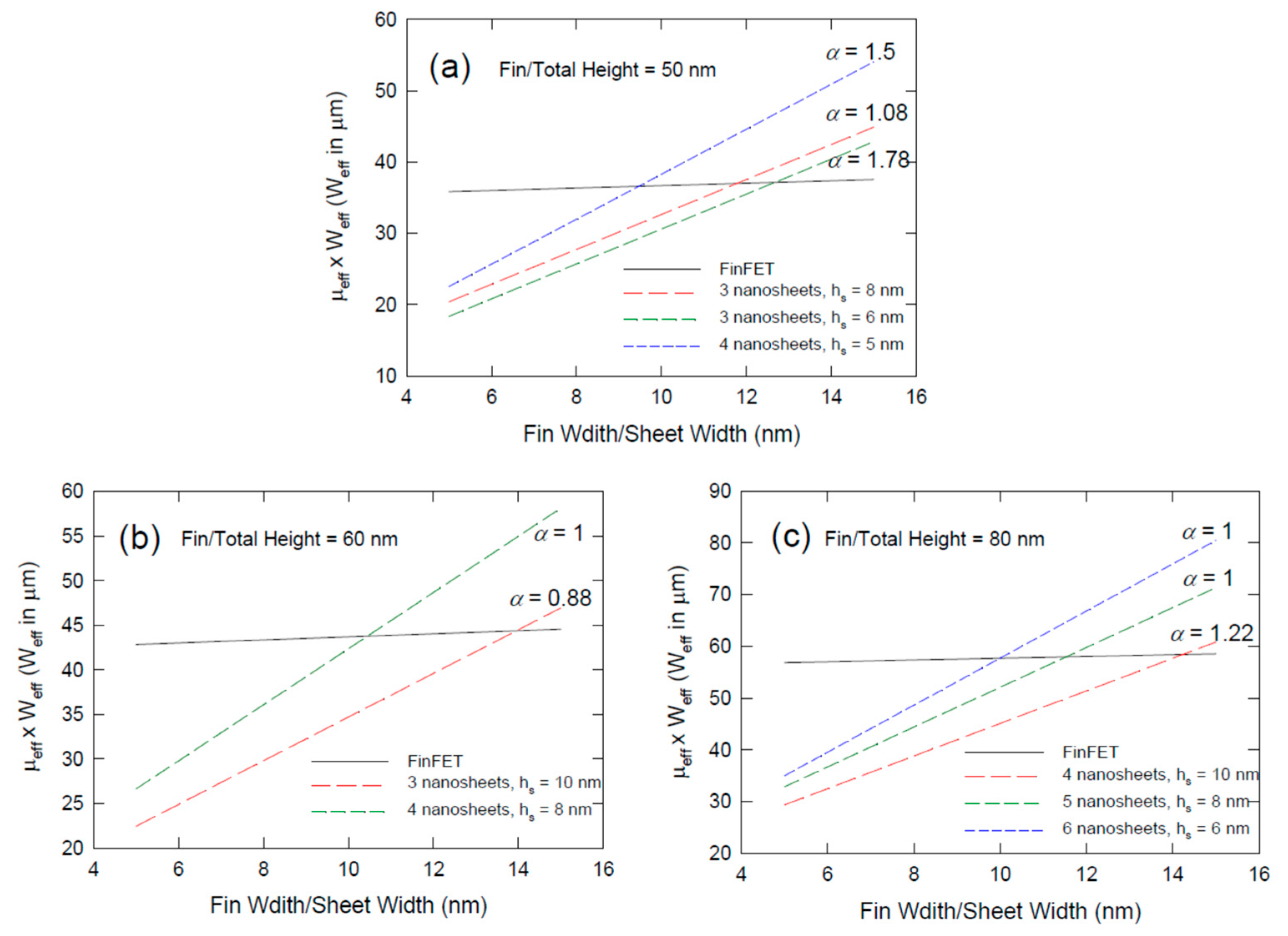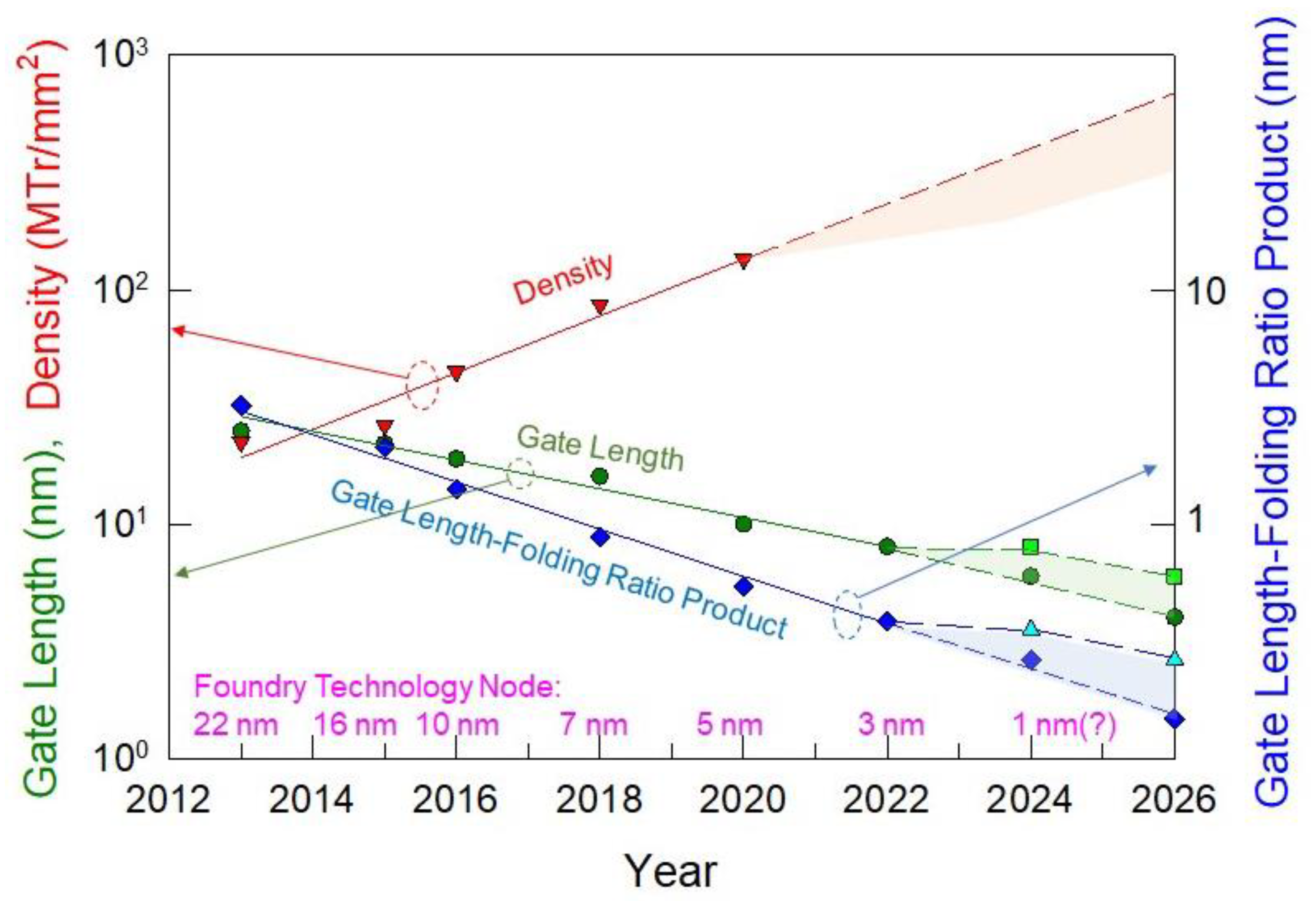On the Vertically Stacked Gate-All-Around Nanosheet and Nanowire Transistor Scaling beyond the 5 nm Technology Node
Abstract
:1. Introduction
2. Width Folding and Moore’s Law Scaling
- The footprints and thus the horizontal channel of most reported nanosheet FETs are usually much larger than the most advanced FinFET technology. Does the advantage remain if the footprint is reduced to 10 nm and smaller?
- The comparison usually takes advantage of nanosheet transistors where the high mobility portion is assigned to larger horizontal parts of the nanosheet channel. In contrast, high mobility is assigned to the negligible top channel region in the FinFET structure. Is the advantage still maintained if the high mobility is re-allocated to the sidewall of a tall fin FinFET?
- Mobilities are found to be significantly degraded due to the significant contribution of the surface region to the channel conduction. What is this effect on the FinFET and VNSFET scaling?
2.1. FinFET Width Folding Ratio
2.2. Width Folding Ratio of Vertically Stacked Nanosheet FET
2.3. Width Folding Ratio of Vertically Stacked Nanowire FET
3. The Effect of Channel Mobility on Scaling
4. Effect of Mobility Nanosheet and Fin Sizing
5. Discussions
6. Conclusions
Author Contributions
Funding
Data Availability Statement
Conflicts of Interest
References
- Iwai, H.; Sze, S.M.; Taur, Y.; Wong, H. MOSFETs. In Guide to State-of-the-Art Electron Devices; Burghartz, J.N., Ed.; Wiley: Hoboken, NJ, USA; IEEE: New York, NY, USA, 2013; pp. 21–36. [Google Scholar]
- Wong, H.; Iwai, H. On the scaling of subnanometer EOT gate dielectrics for ultimate nano CMOS technology. Microelectron. Eng. 2015, 138, 57–76. [Google Scholar] [CrossRef]
- Radamson, H.H.; Zhu, H.L.; Wu, Z.H.; He, X.B.; Lin, H.X.; Liu, J.B.; Xiang, J.J.; Kong, Z.Z.; Wang, G.L.; Li, J.; et al. State of the art and future perspectives in advanced CMOS technology. Nanomaterials 2020, 10, 1555. [Google Scholar] [CrossRef] [PubMed]
- Chaudhry, A.; Kumar, M.J. Controlling short-channel effects in deep submicron SOI MOSFETs for improved reliability: A Review. IEEE Trans. Device Mater. Reliab. 2004, 4, 99–109. [Google Scholar] [CrossRef] [Green Version]
- Young, K.K. Short-channel effect in fully depleted SOI MOSFETs. IEEE Trans. Electron. Devices 1989, 36, 399–402. [Google Scholar] [CrossRef]
- Hisamoto, D.; Lee, W.-C.; Kedzierski, J.; Takeuchi, H.; Asano, K.; Kuo, C.; Anderson, E.; King, T.-J.; Bokor, J.; Hu, C. FinFET-A self-aligned double-gate MOSFET scalable to 20 nm. IEEE Trans. Eelectron. Devices 2000, 47, 2320–2325. [Google Scholar]
- Xie, R.; Montanini, P.; Akarvardar, K.; Tripathi, N.; Haran, B.; Johnson, S.; Hook, T.; Hamieh, B.; Corliss, D.; Wang, J.; et al. A 7 nm FinFET technology featuring EUV patterning and dual strained high mobility channels. In Proceedings of the IEEE International Electron Devices Meeting, San Francisco, CA, USA, 3–7 December 2016; pp. 2.7.1–2.7.4. [Google Scholar]
- Colinge, J.P. Multiple-gate SOI MOSFETs. Solid-State Electron. 2004, 48, 897–905. [Google Scholar] [CrossRef]
- Skotnicki, T.; Fenouillet-Beranger, C.; Gallon, C.; Bœuf, F.; Monfray, S.; Payet, F.; Pouydebasque, A.; Szczap, M.; Farcy, A.; Arnaud, F.; et al. Innovative materials, devices, and CMOS technologies for low-power mobile multimedia. IEEE Trans. Electron. Devices 2008, 55, 96–127. [Google Scholar] [CrossRef]
- Suk, S.D.; Lee, S.Y.; Kim, S.M.; Yoon, E.J.; Kim, M.S.; Li, M.; Oh, C.W.; Yeo, K.H.; Kim, S.H.; Shin, D.S.; et al. High performance 5 nm radius twin silicon nanowire MOSFET (TSNWFET): Fabrication on bulk Si wafer, characteristics, and reliability. In Proceedings of the IEEE International Electron Devices Meeting 2005, Washington, DC, USA, 5 December 2005; pp. 717–720. [Google Scholar]
- Xu, W.; Wong, H.; Iwai, H. Analytical model of drain current of cylindrical surrounding gate p-n-i-n TEFT. Solid-State Electron. 2015, 111, 171–179. [Google Scholar] [CrossRef]
- Sato, S.; Kamimura, H.; Arai, H.; Kakushima, K.; Ahmet, P.; Ohmori, K.; Yamada, K.; Iwai, H. Electrical characterization of Si nanowire field-effect transistors with semi gate-around structure suitable for integration. Solid-State Electron. 2010, 54, 925–928. [Google Scholar] [CrossRef]
- Sato, S.; Kakushima, K.; Ahmet, P.; Ohmori, K.; Natori, K.; Yamada, K.; Iwai, H. Structural advantages of rectangular-like channel cross-section on electrical characteristics of silicon nanowire field-effect transistors. Microelectron. Reliab. 2011, 51, 879–884. [Google Scholar] [CrossRef] [Green Version]
- Ye, P.D.; Ernst, T.; Khare, M.V. The Nanosheet Transistor Is the Next and Maybe Last Step in Moores-Law. Available online: https://comp-eng.binus.ac.id/2019/10/16/the-nanosheet-transistor-is-the-next-and-maybe-last-step-in-moores-law%E2%80%A9/ (accessed on 30 July 2019).
- Loubet, N.; Hook, T.; Montanini, P.; Yeung, C.W.; Kanakasabapathy, S.; Guillom, M.; Yamashita, T.; Zhang, J.; Miao, X.; Wang, J.; et al. Stacked nanosheet gate-all-around transistor to enable scaling beyond FinFET. In Proceedings of the 2017 Symposium on VLSI Technology, Kyoto, Japan, 5–8 June 2017. [Google Scholar]
- Xu, W.J.; Wong, H.; Kakushima, K.; Iwai, H. Quasi-analytical model of ballistic cylindrical surrounding gate nanowire MOSFET. Microelectron. Eng. 2015, 138, 111–117. [Google Scholar] [CrossRef]
- Wong, H.; Yu, Q.; Dong, S.; Kakushima, K.; Iwai, H. Geometry and temperature effects on the threshold voltage characteristics of silicon nanowire MOS transistors. Solid-State Electron. 2017, 138, 35–39. [Google Scholar] [CrossRef]
- Wong, H. On the CMOS device downsizing, more Moore, more than Moore, and more-than-Moore for more Moore. In Proceedings of the IEEE 32nd International Conference on Microelectronics (MIEL), Nis, Serbia, 12–14 September 2021. [Google Scholar]
- Barraud, S.; Lapras, V.; Samson, M.P.; Gaben, L.; Grenouillet, L.; Maffini-Alvaro, V.; Morand, Y.; Daranlot, J.; Rambal, N.; Previtalli, B.; et al. Vertically stacked-nanowires MOSFETs in a replacement metal gate process with inner spacer and SiGe source/drain. In Proceedings of the IEEE International Electron Devices Meeting, San Francisco, CA, USA, 3–7 December 2016; pp. 17.6.1–17.6.4. [Google Scholar]
- Tachi, K.; Vulliet, N.; Barraud, S.; Kakushima, K.; Iwai, H.; Cristoloveanu, S.; Ernst, T. Influence of source/drain formation process on resistance and effective mobility for scaled multi-channel MOSFET. Solid-State Electron. 2011, 65–66, 16–21. [Google Scholar] [CrossRef]
- Tachi, K.; Barraud, S.; Kakushima, K.; Iwai, H.; Cristoloveanu, S.; Ernst, T. Comparison of low-temperature electrical characteristics of gate-all-around nanowire FETs, Fin FETs and fully-depleted SOI FETs. Microelectron. Reliab. 2011, 51, 885–888. [Google Scholar] [CrossRef]
- Wong, H. Nano CMOS Gate Dielectric Engineering; CRC Press: Boca Raton, FL, USA, 2012. [Google Scholar]
- Wong, H.; Zhang, J.; Iwai, H.; Kakushima, K. Characteristic variabilities of subnanometer EOT La2O3 gate dielectric film of nano CMOS devices. Nanomaterials 2021, 11, 2118. [Google Scholar] [CrossRef] [PubMed]
- Spessot, A.; Ritzenthaler, R.; Litta, E.D.; Dupuy, E.; O’Sullivan, B.; Bastos, J.; Capogreco, E.; Miyaguchi, K.; Machkaoutsan, V.; Yoon, Y.; et al. 80 nm tall thermally stable cost effective FinFETs for advanced dynamic random access memory periphery devices for artificial intelligence/machine learning and automotive applications. Jap. J. Appl. Phys. 2021, 60, SBBB06. [Google Scholar] [CrossRef]
- Chen, J.; Saraya, T.; Miyaji, K.; Shimizu, K.; Hiramoto, T. Experimental study of mobility in [110]- and [100]-directed multiple silicon nanowire GAA MOSFETs on (100) SOI. In Proceedings of the 2008 Symposium on VLSI Technology, Honolulu, HI, USA, 17–19 June 2008; pp. 32–33. [Google Scholar]
- Xie, L.; Zhu, H.; Zhang, Y.; Ai, X.; Li, J.; Wang, G.; Du, A.; Kong, Z.; Wang, Q.; Lu, S.; et al. Investigation on Ge0.8Si0.2-selective atomic layer wet-etching of Ge for vertical gate-all-around nanodevice. Nanomaterials 2021, 11, 1408. [Google Scholar] [CrossRef] [PubMed]
- Li, Y.Y.; Zhu, H.L.; Kong, Z.Z.; Zhang, Y.K.; Ai, X.Z.; Wang, G.L.; Wang, Q.; Liu, Z.Y.; Lu, S.S.; Xie, L.; et al. The effect of doping on the digital etching of silicon-selective silicon–germanium using nitric acids. Nanomaterials 2021, 11, 1209. [Google Scholar] [CrossRef] [PubMed]
- Barraud, S.; Previtali, B.; Vizioz, C.; Hartmann, J.M.; Sturm, J.; Lassarre, J.; Perrot, C.; Rodriguez, P.; Loup, V.; Magalhaes-Lucas, A.; et al. 7-levels-stacked nanosheet GAA transistors for high performance computing. In Proceedings of the 2020 IEEE Symposium on VLSI Technology, Honolulu, HI, USA, 16–19 June 2020; pp. 1–2. [Google Scholar]
- Jang, D.; Yakimets, D.; Eneman, G.; Schuddinck, P.; Bardon, M.G.; Raghavan, P.; Spessot, A.; Verkest, D.; Mocuta, A. Device exploration of nanoSheet transistors for sub-7-nm technology node. IEEE Trans. Electron. Devices 2017, 64, 2707–2713. [Google Scholar] [CrossRef]







Publisher’s Note: MDPI stays neutral with regard to jurisdictional claims in published maps and institutional affiliations. |
© 2022 by the authors. Licensee MDPI, Basel, Switzerland. This article is an open access article distributed under the terms and conditions of the Creative Commons Attribution (CC BY) license (https://creativecommons.org/licenses/by/4.0/).
Share and Cite
Wong, H.; Kakushima, K. On the Vertically Stacked Gate-All-Around Nanosheet and Nanowire Transistor Scaling beyond the 5 nm Technology Node. Nanomaterials 2022, 12, 1739. https://doi.org/10.3390/nano12101739
Wong H, Kakushima K. On the Vertically Stacked Gate-All-Around Nanosheet and Nanowire Transistor Scaling beyond the 5 nm Technology Node. Nanomaterials. 2022; 12(10):1739. https://doi.org/10.3390/nano12101739
Chicago/Turabian StyleWong, Hei, and Kuniyuki Kakushima. 2022. "On the Vertically Stacked Gate-All-Around Nanosheet and Nanowire Transistor Scaling beyond the 5 nm Technology Node" Nanomaterials 12, no. 10: 1739. https://doi.org/10.3390/nano12101739
APA StyleWong, H., & Kakushima, K. (2022). On the Vertically Stacked Gate-All-Around Nanosheet and Nanowire Transistor Scaling beyond the 5 nm Technology Node. Nanomaterials, 12(10), 1739. https://doi.org/10.3390/nano12101739





